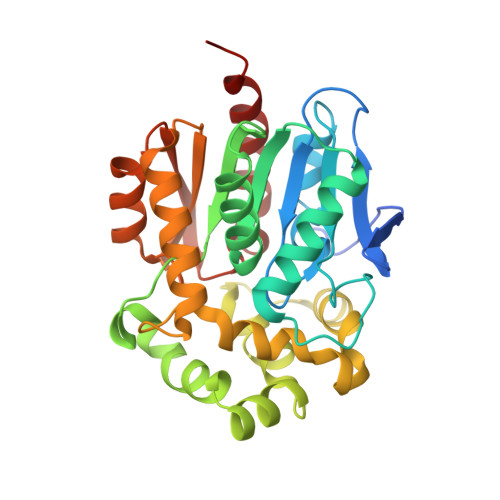A modular chemigenetic calcium indicator for multiplexed in vivo functional imaging.
Farrants, H., Shuai, Y., Lemon, W.C., Monroy Hernandez, C., Zhang, D., Yang, S., Patel, R., Qiao, G., Frei, M.S., Plutkis, S.E., Grimm, J.B., Hanson, T.L., Tomaska, F., Turner, G.C., Stringer, C., Keller, P.J., Beyene, A.G., Chen, Y., Liang, Y., Lavis, L.D., Schreiter, E.R.(2024) Nat Methods 21: 1916-1925
- PubMed: 39304767
- DOI: https://doi.org/10.1038/s41592-024-02411-6
- Primary Citation of Related Structures:
8SW8 - PubMed Abstract:
Genetically encoded fluorescent calcium indicators allow cellular-resolution recording of physiology. However, bright, genetically targetable indicators that can be multiplexed with existing tools in vivo are needed for simultaneous imaging of multiple signals. Here we describe WHaloCaMP, a modular chemigenetic calcium indicator built from bright dye-ligands and protein sensor domains. Fluorescence change in WHaloCaMP results from reversible quenching of the bound dye via a strategically placed tryptophan. WHaloCaMP is compatible with rhodamine dye-ligands that fluoresce from green to near-infrared, including several that efficiently label the brain in animals. When bound to a near-infrared dye-ligand, WHaloCaMP shows a 7× increase in fluorescence intensity and a 2.1-ns increase in fluorescence lifetime upon calcium binding. We use WHaloCaMP1a to image Ca 2+ responses in vivo in flies and mice, to perform three-color multiplexed functional imaging of hundreds of neurons and astrocytes in zebrafish larvae and to quantify Ca 2+ concentration using fluorescence lifetime imaging microscopy (FLIM).
- Janelia Research Campus, Howard Hughes Medical Institute, Ashburn, VA, USA. farrantsh@janelia.hhmi.org.
Organizational Affiliation:


















